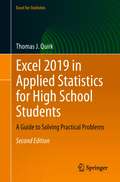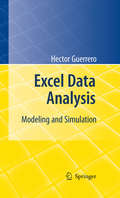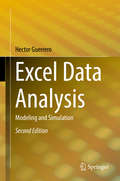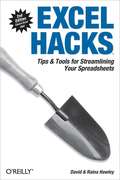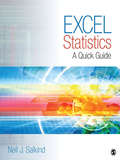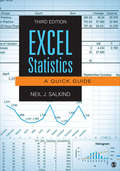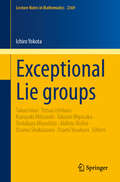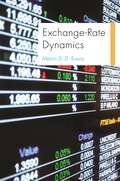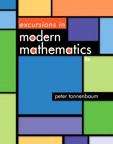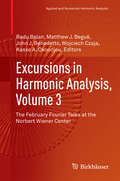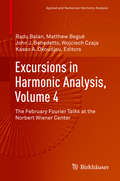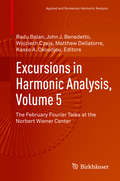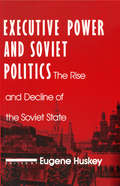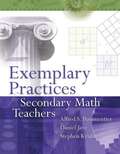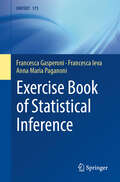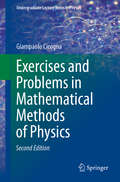- Table View
- List View
Excel 2019 in Applied Statistics for High School Students: A Guide to Solving Practical Problems (Excel for Statistics)
by Thomas J. QuirkThis textbook is a step-by-step guide for high school, community college, and undergraduate students who are taking a course in applied statistics and wish to learn how to use Excel to solve statistical problems. All of the statistics problems in this book come from the following fields of study: business, education, psychology, marketing, engineering and advertising. Students will learn how to perform key statistical tests in Excel without being overwhelmed by statistical theory. Each chapter briefly explains a topic and then demonstrates how to use Excel commands and formulas to solve specific statistics problems. The book offers guidance in using Excel in two different ways: (1) writing formulas (e.g., confidence interval about the mean, one-group t-test, two-group t-test, correlation) and (2) using Excel’s drop-down formula menus (e.g., simple linear regression, multiple correlations and multiple regression, and one-way ANOVA). Three practice problems are provided at the end of each chapter, along with their solutions in an appendix. An additional practice test allows readers to test their understanding of each chapter by attempting to solve a specific statistics problem using Excel; the solution to each of these problems is also given in an appendix. This book is a tool that can be used either by itself or along with any good statistics book.
Excel Data Analysis
by Hector GuerreroThis book is written for the students and practitioners who are looking for a single introductory Excel-based resource that covers three essential business and analytical skills--Data Analysis, Business Modeling, and Simulation of Complex Problems. The focus of the book is clearly on analysis of problems for decision making, yet detailed explanations regarding how to use Excel tools are provided. After many years of teaching and consulting, it is abundantly clear to me that for most students, a good example is worth its weight in gold. This book contains many excellent examples in each chapter, some simple and others more complex, and there is an abundance of exhibits to guide the student through the maze of steps necessary for each analysis. The content is quite diverse: * data presentation -- the Feng Shui of spreadsheets, effective communication and collaboration * data preparation -- import, scrub, manipulate data * data analysis -- statistical methods: descriptive, inferential, and predictive, Design of Experiments * modeling -- deterministic, probabilistic, What-if, Scenarios * simulation -- quantifying uncertainty, Monte Carlo Simulation * optimization -- constrained, Linear Programming, non-linear models, Goal Seek * Couple these features with detailed discussions of how to realistically organize and extract insight from complex problems, and I believe you have a unique educational combination in one book.
Excel Data Analysis: Modeling And Simulation
by Hector GuerreroThis book offers a comprehensive and readable introduction to modern business and data analytics. It is based on the use of Excel, a tool that virtually all students and professionals have access to. The explanations are focused on understanding the techniques and their proper application, and are supplemented by a wealth of in-chapter and end-of-chapter exercises. In addition to the general statistical methods, the book also includes Monte Carlo simulation and optimization. The second edition has been thoroughly revised: new topics, exercises and examples have been added, and the readability has been further improved. The book is primarily intended for students in business, economics and government, as well as professionals, who need a more rigorous introduction to business and data analytics – yet also need to learn the topic quickly and without overly academic explanations.
Excel Hacks: Tips & Tools for Streamlining Your Spreadsheets
by David Hawley Raina HawleyMillions of users create and share Excel spreadsheets every day, but few go deeply enough to learn the techniques that will make their work much easier. There are many ways to take advantage of Excel's advanced capabilities without spending hours on advanced study. Excel Hacks provides more than 130 hacks -- clever tools, tips and techniques -- that will leapfrog your work beyond the ordinary.Now expanded to include Excel 2007, this resourceful, roll-up-your-sleeves guide gives you little known "backdoor" tricks for several Excel versions using different platforms and external applications. Think of this book as a toolbox. When a need arises or a problem occurs, you can simply use the right tool for the job. Hacks are grouped into chapters so you can find what you need quickly, including ways to:Reduce workbook and worksheet frustration -- manage how users interact with worksheets, find and highlight information, and deal with debris and corruption.Analyze and manage data -- extend and automate these features, moving beyond the limited tasks they were designed to perform.Hack names -- learn not only how to name cells and ranges, but also how to create names that adapt to the data in your spreadsheet.Get the most out of PivotTables -- avoid the problems that make them frustrating and learn how to extend them.Create customized charts -- tweak and combine Excel's built-in charting capabilities.Hack formulas and functions -- subjects range from moving formulas around to dealing with datatype issues to improving recalculation time.Make the most of macros -- including ways to manage them and use them to extend other features.Use the enhanced capabilities of Microsoft Office 2007 to combine Excel with Word, Access, and Outlook.You can either browse through the book or read it from cover to cover, studying the procedures and scripts to learn more about Excel. However you use it, Excel Hacks will help you increase productivity and give you hours of "hacking" enjoyment along the way.
Excel Scientific and Engineering Cookbook: Adding Excel to Your Analysis Arsenal
by David M BourgGiven the improved analytical capabilities of Excel, scientists and engineers everywhere are using it--instead of FORTRAN--to solve problems. And why not? Excel is installed on millions of computers, features a rich set of built-in analyses tools, and includes an integrated Visual Basic for Applications (VBA) programming language. No wonder it's today's computing tool of choice. Chances are you already use Excel to perform some fairly routine calculations. Now the Excel Scientific and Engineering Cookbook shows you how to leverage Excel to perform more complex calculations, too, calculations that once fell in the domain of specialized tools. It does so by putting a smorgasbord of data analysis techniques right at your fingertips. The book shows how to perform these useful tasks and others:Use Excel and VBA in generalImport data from a variety of sourcesAnalyze dataPerform calculationsVisualize the results for interpretation and presentationUse Excel to solve specific science and engineering problemsWherever possible, the Excel Scientific and Engineering Cookbook draws on real-world examples from a range of scientific disciplines such as biology, chemistry, and physics. This way, you'll be better prepared to solve the problems you face in your everyday scientific or engineering tasks.High on practicality and low on theory, this quick, look-up reference provides instant solutions, or "recipes," to problems both basic and advanced. And like other books in O'Reilly's popular Cookbook format, each recipe also includes a discussion on how and why it works. As a result, you can take comfort in knowing that complete, practical answers are a mere page-flip away.
Excel Statistics: A Quick Guide
by Neil J. SalkindBecome a pro at using Excel for statistical analysis! Designed for users already familiar with basic computer operations, Neil J. Salkind's Excel Statistics: A Quick Guide shows readers how to utilize the features of Microsoft Excel to answer both simple and complex questions about data analysis. Excel novices and experts alike will find this text not only practical but easy to use and engaging.
Excel Statistics: A Quick Guide
by Neil J. SalkindIdeal for those already familiar with basic Excel features, this updated Third Edition of Neil J. Salkind’s Excel Statistics: A Quick Guide shows readers how to utilize Microsoft® Excel’s functions and Analysis ToolPak to answer simple and complex questions about data. Part I explores 35 Excel functions, while Part II contains 20 Analysis ToolPak tools. To make it easy to see what each function or tool looks like when applied, at-a-glance two-page spreads describe each function and its use with corresponding screenshots. In addition, actual data files used in the examples are readily available online at an open-access Student Study Site.
Excel Statistics: A Quick Guide
by Neil J. SalkindIdeal for those already familiar with basic Excel features, this updated Third Edition of Neil J. Salkind’s Excel Statistics: A Quick Guide shows readers how to utilize Microsoft® Excel’s functions and Analysis ToolPak to answer simple and complex questions about data. Part I explores 35 Excel functions, while Part II contains 20 Analysis ToolPak tools. To make it easy to see what each function or tool looks like when applied, at-a-glance two-page spreads describe each function and its use with corresponding screenshots. In addition, actual data files used in the examples are readily available online at an open-access Student Study Site.
Exceptional Lie Algebras (Lecture Notes in Pure and Applied Mathematics #1)
by N. JacobsonThis volume presents a set of models for the exceptional Lie algebras over algebraically closed fieldsof characteristic O and over the field of real numbers. The models given are based on the algebras ofCayley numbers (octonions) and on exceptional Jordan algebras. They are also valid forcharacteristics p * 2. The book also provides an introduction to the problem of forms of exceptionalsimple Lie algebras, especially the exceptional D4 's, � 6 's, and � 7 's. These are studied by means ofconcrete realizations of the automorphism groups.Exceptional Lie Algebras is a useful tool for the mathematical public in general-especially thoseinterested in the classification of Lie algebras or groups-and for theoretical physicists.
Exceptional Lie groups (Lecture Notes in Mathematics #2369)
by Ichiro YokotaThis book provides a concrete description of the identity connected components of the real and complex exceptional Lie groups. The constructions are elementary and improve on those of H. Freudenthal. The complex simple Lie algebras were classified into classical (An, Bn, Cn, Dn) and exceptional (G2, F4, E6, E7, E8) types at the end of the 19th century by W. Killing and É. Cartan. These simple Lie algebras and the corresponding compact simple Lie groups arise in many settings in mathematics and physics. The exceptional Lie groups form an especially interesting class of objects that have attracted the attention of numerous mathematicians. Requiring no prior knowledge of composition algebras or Jordan algebras, the book will be valuable to anyone who wants to learn about the structure and realizations of these fascinating groups.
Exceptional Lifespans (Demographic Research Monographs)
by James W. Vaupel Heiner Maier Bernard JeuneHow long can humans live? This open access book documents, verifies and brings to life the advance of the frontier of human survival. It carefully validates data on supercentenarians, aged 110+, and semi-supercentenarians, aged 105-109, stored in the International Database on Longevity (IDL). The chapters in this book contribute substantial advances in rigorously checked facts about exceptional lifespans and in the application of state-of-the-art analytical strategies to understand trends and patterns in these rare lifespans. The book includes detailed accounts of extreme long-livers and how their long lifespans were documented, as well as reports on the causes of death at the oldest ages. Its key finding, based on the analysis of 1,219 validated supercentenarians, is that the annual probability of death is constant at 50% after age 110. In contrast to previous assertions about a ceiling on the human lifespan, evidence presented in this book suggests that lifespan records in specific countries and globally will be broken again and again as more people survive to become supercentenarians.
Exchange-Rate Dynamics (Princeton Series in International Economics)
by Martin D. EvansA comprehensive and in-depth look at exchange-rate dynamicsVariations in the foreign exchange market influence all aspects of the world economy, and understanding these dynamics is one of the great challenges of international economics. This book provides a new, comprehensive, and in-depth examination of the standard theories and latest research in exchange-rate economics. Covering a vast swath of theoretical and empirical work, the book explores established theories of exchange-rate determination using macroeconomic fundamentals, and presents unique microbased approaches that combine the insights of microstructure models with the macroeconomic forces driving currency trading.Macroeconomic models have long assumed that agents—households, firms, financial institutions, and central banks—all have the same information about the structure of the economy and therefore hold the same expectations and uncertainties regarding foreign currency returns. Microbased models, however, look at how heterogeneous information influences the trading decisions of agents and becomes embedded in exchange rates. Replicating key features of actual currency markets, these microbased models generate a rich array of empirical predictions concerning trading patterns and exchange-rate dynamics that are strongly supported by data. The models also show how changing macroeconomic conditions exert an influence on short-term exchange-rate dynamics via their impact on currency trading.Designed for graduate courses in international macroeconomics, international finance, and finance, and as a go-to reference for researchers in international economics, Exchange-Rate Dynamics guides readers through a range of literature on exchange-rate determination, offering fresh insights for further reading and research.Comprehensive and in-depth examination of the latest research in exchange-rate economicsOutlines theoretical and empirical research across the spectrum of modeling approachesPresents new results on the importance of currency trading in exchange-rate determinationProvides new perspectives on long-standing puzzles in exchange-rate economicsEnd-of-chapter questions cement key ideas
Excursions In Modern Mathematics
by Peter TannenbaumExcursions in Modern Mathematics introduces you to the power of math by exploring applications like social choice and management science, showing that math is more than a set of formulas. Ideal for an applied liberal arts math course, Tannenbaum's text is known for its clear, accessible writing style and its unique exercise sets that build in complexity from basic to more challenging. The Eighth Edition offers more real data and applications to connect with today's readesr, expanded coverage of applications like growth, and revised exercise sets.
Excursions in Harmonic Analysis, Volume 1
by Radu Balan Wojciech Czaja Travis D Andrews John J. Benedetto Kasso A. OkoudjouThe Norbert Wiener Center for Harmonic Analysis and Applications provides a state-of-the-art research venue for the broad emerging area of mathematical engineering in the context of harmonic analysis. This two-volume set consists of contributions from speakers at the February Fourier Talks (FFT) from 2006-2011. The FFT are organized by the Norbert Wiener Center in the Department of Mathematics at the University of Maryland, College Park. These volumes span a large spectrum of harmonic analysis and its applications. They are divided into the following parts: Volume I · Sampling Theory · Remote Sensing · Mathematics of Data Processing · Applications of Data Processing Volume II · Measure Theory · Filtering · Operator Theory · Biomathematics Each part provides state-of-the-art results, with contributions from an impressive array of mathematicians, engineers, and scientists in academia, industry, and government. Excursions in Harmonic Analysis: The February Fourier Talks at the Norbert Wiener Center is an excellent reference for graduate students, researchers, and professionals in pure and applied mathematics, engineering, and physics.
Excursions in Harmonic Analysis, Volume 2
by Radu Balan Wojciech Czaja Travis D Andrews John J. Benedetto Kasso A. OkoudjouThe Norbert Wiener Center for Harmonic Analysis and Applications provides a state-of-the-art research venue for the broad emerging area of mathematical engineering in the context of harmonic analysis.<P><P> This two-volume set consists of contributions from speakers at the February Fourier Talks (FFT) from 2006-2011. The FFT are organized by the Norbert Wiener Center in the Department of Mathematics at the University of Maryland, College Park. These volumes span a large spectrum of harmonic analysis and its applications. They are divided into the following parts:<P> Volume I<P> · Sampling Theory<P> · Remote Sensing<P> · Mathematics of Data Processing<P> · Applications of Data Processing<P> Volume II<P> · Measure Theory<P> · Filtering<P> · Operator Theory<P> · Biomathematics<P> Each part provides state-of-the-art results, with contributions from an impressive array of mathematicians, engineers, and scientists in academia, industry, and government.<P> Excursions in Harmonic Analysis: The February Fourier Talks at the Norbert Wiener Center is an excellent reference for graduate students, researchers, and professionals in pure and applied mathematics, engineering, and physics.
Excursions in Harmonic Analysis, Volume 3
by Radu Balan Wojciech Czaja John J. Benedetto Kasso A. Okoudjou Matthew J. BeguéThis volume consists of contributions spanning a wide spectrum of harmonic analysis and its applications written by speakers at the February Fourier Talks from 2002 - 2013. Containing cutting-edge results by an impressive array of mathematicians, engineers, and scientists in academia, industry, and government, it will be an excellent reference for graduate students, researchers, and professionals in pure and applied mathematics, physics, and engineering. Topics covered include #65533; spectral analysis and correlation; #65533; radar and communications: design, theory, and applications; #65533; sparsity #65533; special topics in harmonic analysis. The February Fourier Talks are held annually at the Norbert Wiener Center for Harmonic Analysis and Applications. Located at the University of Maryland, College Park, the Norbert Wiener Center provides a state-of- the-art research venue for the broad emerging area of mathematical engineering.
Excursions in Harmonic Analysis, Volume 4
by Radu Balan Wojciech Czaja John J. Benedetto Kasso A. Okoudjou Matthew BeguéThis volume consists of contributions spanning a wide spectrum of harmonic analysis and its applications written by speakers at the February Fourier Talks from 2002 - 2013. Containing cutting-edge results by an impressive array of mathematicians, engineers and scientists in academia, industry and government, it will be an excellent reference for graduate students, researchers and professionals in pure and applied mathematics, physics and engineering. Topics covered include: Special Topics in Harmonic Analysis Applications and Algorithms in the Physical Sciences Gabor Theory RADAR and Communications: Design, Theory, and Applications The February Fourier Talks are held annually at the Norbert Wiener Center for Harmonic Analysis and Applications. Located at the University of Maryland, College Park, the Norbert Wiener Center provides a state-of- the-art research venue for the broad emerging area of mathematical engineering.
Excursions in Harmonic Analysis, Volume 5
by Radu Balan Wojciech Czaja John J. Benedetto Kasso A. Okoudjou Matthew DellatorreThis volume consists of contributions spanning a wide spectrum of harmonic analysis and its applications written by speakers at the February Fourier Talks from 2002 - 2016. Containing cutting-edge results by an impressive array of mathematicians, engineers, and scientists in academia, industry and government, it will be an excellent reference for graduate students, researchers, and professionals in pure and applied mathematics, physics, and engineering. Topics covered include: Theoretical harmonic analysis Image and signal processing Quantization Algorithms and representations The February Fourier Talks are held annually at the Norbert Wiener Center for Harmonic Analysis and Applications. Located at the University of Maryland, College Park, the Norbert Wiener Center provides a state-of- the-art research venue for the broad emerging area of mathematical engineering.
Excursions in Harmonic Analysis, Volume 6: In Honor of John Benedetto’s 80th Birthday (Applied and Numerical Harmonic Analysis)
by Kasso A. Okoudjou Matthew Hirn Shidong Li Sandra Saliani Özgür YilmazJohn J. Benedetto has had a profound influence not only on the direction of harmonic analysis and its applications, but also on the entire community of people involved in the field. The chapters in this volume – compiled on the occasion of his 80th birthday – are written by leading researchers in the field and pay tribute to John’s many significant and lasting achievements. Covering a wide range of topics in harmonic analysis and related areas, these chapters are organized into four main parts: harmonic analysis, wavelets and frames, sampling and signal processing, and compressed sensing and optimization. An introductory chapter also provides a brief overview of John’s life and mathematical career. This volume will be an excellent reference for graduate students, researchers, and professionals in pure and applied mathematics, engineering, and physics.
Excursions in Ill-Condensed Quantum Matter: From Amorphous Topological Insulators to Fractional Spins (Springer Theses)
by Adhip AgarwalaImpurities, disorder or amorphous systems – ill-condensed matter – are mostly considered inconveniences in the study of materials, which is otherwise heavily based on idealized perfect crystals. The Kondo effect and the scaling theory of localization are among the fundamental and early discoveries which revealed the novelty hidden in impure or disordered systems. Recent advances in condensed matter physics have emphasized the role of topology, spin-orbit coupling, and certain discrete symmetries such as time reversal in many physical phenomena. These have irreversibly transformed the essential ideas and purview of condensed matter physics, both in theoretical and experimental directions. However, many of these recent developments and their implications are limited to, or by, ideas that pertain to clean systems. This thesis deals with various aspects of these new developments, but in the case of unclean systems. The author introduces new ideas such as amorphous topological insulators, fractalized metals and fractionalized spins.
Excursions into Mathematics: The Millennium Edition
by Anatole Beck Michael N. Bleicher Donald W. CroweSince it was first published three decades ago, Excursions Into Mathematics has been one of the most popular mathematical books written for a general audience. Taking the reader for short "excursions" into several specific disciplines of mathematics, it makes mathematical concepts accessible to a wide audience. The Millennium Edition is updated with current research and new solutions to outstanding problems that have been discovered since the last edition was printed, such as the solution to the well-known "four-color problem." Excursions Into Mathematics: The Millennium Edition is an exciting revision of the original, much-loved classic. Everyone with an interest in mathematics should read this book.
Executive Power and Soviet Politics (Contemporary Soviet - Post-soviet Politics Ser.)
by Eugene HuskeyEver since the behavioral revolution reached Communist studies more than 2 decades ago, Western scholarship has tended to ignore the powerful and unwieldy institutional structure of the Soviet government. Today, suddenly, it is clear that the dramatic political and legislative reforms of the Gorbachev years will remain incomplete as long as the issues of state bureaucratic power and executive prerogative are unresolved. This volume, brings together original studies of the Soviet executive under Gorbachev by specialists including Barbara Chotiner, Stephen Fortescue, Brnda Horrigan, Ellen Jones, Wayne Limberg, T.H. Rigby and Louise Shelley. Among the topics covered are the major economic, national security and law enforcement ministries, the presidency, the cabinet and questions of presidential-ministerial, presidential-presidential, legislative-executive and party-state relations.
Exemplary Practices for Secondary Math Teachers
by Alfred S. Posamentier Stephen Krulik Daniel JayeEvery year new secondary mathematics teachers take up positions in middle and high schools. The luckiest novices receive assistance from a coach or mentor: a master mathematics teacher who makes constructive comments, models effective approaches, and illuminates other practical aspects of teaching secondary math. But many new teachers don t have this advantage and must further their development on their own. If you are one of these teachers, this is the book you need. <p><p> In these pages, veteran mathematics educators Alfred S. Posamentier, Daniel Jaye, and Stephen Krulik present a treasure chest of ideas to guide new secondary math teachers through the challenging first few months and also provide more experienced teachers with interesting alternatives to familiar methods.
Exercise Book of Statistical Inference (UNITEXT #173)
by Anna Maria Paganoni Francesca Ieva Francesca GasperoniThis book was created with the goal of helping students transition from the theoretical and methodological concepts of statistical inference to their implementation on a computer. The first part of the book is primarily focused on exercises to be solved with pen and paper, so that students can apply knowledge derived from lemmas and theorems; while the second part consists of labs, which involve both the manual implementation of algorithms and the learning of built-in tools for efficient analysis of datasets derived from real-world problems. To optimize the understanding of the topics developed and to guide the reader through their studies, the book is organized into chapters, each of which includes an introductory section that reviews the theoretical foundations of statistical inference, followed by a second part with exercises, each accompanied by a comprehensive solution on paper and, when appropriate, using software. This book is aimed at undergraduate students in Statistics, Mathematics, Engineering, and for graduate-level courses in Data Science.
Exercises and Problems in Mathematical Methods of Physics (Undergraduate Lecture Notes in Physics)
by Giampaolo CicognaThis book is the second edition, whose original mission was to offer a new approach for students wishing to better understand the mathematical tenets that underlie the study of physics. This mission is retained in this book.The structure of the book is one that keeps pedagogical principles in mind at every level. Not only are the chapters sequenced in such a way as to guide the reader down a clear path that stretches throughout the book, but all individual sections and subsections are also laid out so that the material they address becomes progressively more complex along with the reader's ability to comprehend it. This book not only improves upon the first in many details, but it also fills in some gaps that were left open by this and other books on similar topics. The 350 problems presented here are accompanied by answers which now include a greater amount of detail and additional guidance for arriving at the solutions. In this way, the mathematical underpinnings of the relevant physics topics are made as easy to absorb as possible.
